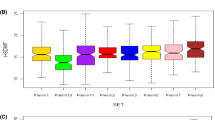Summary
The availability of yield and combining ability data on germplasm bank accessions may increase their use, but collection of this type of data from a large number of accessions is difficult and expensive. This study was conducted to determine whether the members of the top 20% of evaluated accessions changed so extensively, when evaluations were repeated over locations and years, that initial evaluations conducted in one location were misleading. Thirty-four Yugoslavian maize (Zea mays L.) accessions were evaluated for yield per se and as test crosses to eight testers in three Iowa locations during three years. Overall “best” accessions were assumed to be those that performed best, as judged by all of the data. The highest yields occurred in Kanawha, Iowa, in 1987, which had favorable climatic conditions for maize production, whereas the lowest were in Kanawha in 1985, which had the least desirable conditions. In these two years, however, one testcross evaluation placed more of the actual overall best accessions in the top 20% of the highest yielding accessions for that particular evaluation. More “overall best” were ranked in the top 20% in the year with less desirable conditions. The efficiency of an environment in ranking the best accessions in the top 20%, while excluding the worst 20%, ranged from 16% in Nashua, Iowa, in 1985 to 48% in Nashua in 1986. Repeating evaluation trials over years was no more efficient than repeating them over locations, or vice versa. Initial germplasm evaluations should be repeated either over locations or years, to increase the probability of identifying the rare agronomically valuable accessions and eliminating poorer-yielding ones.
Similar content being viewed by others
References
Abel, B.C. & L.M. Pollak, 1991. Rank comparisons of unadapted maize populations by testers and per se evaluation. Crop Sci. 31: 650–656.
Castillo-Gonzalez, F. & M.M. Goodman, 1989. Agronomic evaluation of Latin American maize accessions. Crop Sci. 29: 853–861.
Committee on Managing Global Genetic Resources: Agricultural Imperatives, 1991. Managing global genetic resources, The U.S. national plant germplasm system. National Academy Press, Washington, D.C.
Crossa, J., S. Taba & E.J. Wellhausen, 1990. Heterotic patterns among Mexican races of maize. Crop Sci. 30: 1182–1190.
Frankel, O.H., 1977. Genetic resources. Ann. N.Y. Acad. Sci. 287: 332–344.
Frankel, O.H., 1989. Principles and strategies of evaluation. In: A.H.D. Brown, O.H. Frankel, D.R. Marshall & J.T. Williams (Eds.), The Use of Plant Genetic Resources, pp. 245–260, Cambridge Univ. Press, Cambridge.
Goodman, M.M., 1988. U.S. maize germplasm: origins, limitations, and alternatives. In: Recent advances in the conservation and utilization of genetic resources: Proceedings of the global maize germplasm workshop, pp. 130–148, Mexico City, 6–12 Mar. 1988. CIMMYT, El Batan, Mexico.
Goodman, M.M., 1990. Genetic and germ plasm stocks worth conserving. J. Hered. 81: 11–16.
Kannenberg, L.W., 1984. Utilization of genetic diversity in crop breeding. In: C.W. Yeatman, D. Kafton & G. Wilkes (Eds.), Plant Gentic Resources A Conservation Imperative, pp. 93–109, Westview Press, Boulder, Colorado.
Marshall, D.R., 1989. Limitations to the use of germplasm collections. In: A.H.D. Brown, O.H. Frankel, D.R. Marshall & J.T. Williams (Eds.), The Use of Plant Genetic Resources, pp. 105–120, Cambridge Univ. Press, Cambridge.
Matzinger, D.F., G.F. Sprague & C.C. Cockerham, 1959. Diallel crosses of maize in experiments repeated over locations and years. Agron. J. 51: 346–350.
Olson, R.A. & D.H. Sander, 1988. Corn Production. In: G.F. Sprague & J.W. Dudley (Eds.), Corn and Corn Production, pp. 639–686, ASA-CSSA-SSSA, Madison, WI.
Ortiz-Valdez, M., 1985. Climatic delineation of maize production areas in Iowa: A multivariate statistical analysis. Ph.D. Diss. Iowa State Univ., Ames, IA (Diss. Abstr. 85–24684).
Pavličić, J. & V. Trifunović, 1966. A study of some important ecologic corn types grown in Yugoslavia and their classification. J. Sci. Agric. Res. 19: 45–63.
Plucknett, D.L., N.J.H. Smith, J.T. Williams & N.M. Anishetty, 1987. Gene banks and the world's food. Princeton Univ. Press, Princeton, N.J.
Salhuana, W., Q. Jones & R. Sevilla, 1991. The Latin American Maize Project: Model for rescue and use of irreplaceable germplasm. Diversity 7: 40–42.
Smith, J.S.C. & D.N. Duvick, 1989. Germplasm collections and the private plant breeder. In: A.H.D. Brown, O.H. Frankel, D.R. Marshall & J.T. Williams (Eds.), The Use of Plant Genetic Resources, pp. 17–31, Cambridge Univ. Press, Cambridge.
Sprague, G.F. & W.T. Federer, 1951. A comparison of variance components in corn yield trials: II. Error, year × variety, location × variety, and variety components. Agron. J. 43: 535–541.
Wilkes, G., 1984. Germplasm conservation toward the year 2000: Potential for new crops and enhancement of present crops. In: C.W. Yeatman, D. Kafton & G. Wilkes (Eds.), Plant Genetic Resources, A Conservation Imperative, pp. 131–164, Westview Press, Inc., Boulder, Colorado.
Williams, J.T., 1989. Practical considerations relevant to effective evaluation. In: A.H.D. Brown, O.H. Frankel, D.R. Marshall & J.T. Williams (Eds.), The Use of Plant Genetic Resources, pp. 235–244, Cambridge Univ. Press, Cambridge.
Author information
Authors and Affiliations
Rights and permissions
About this article
Cite this article
Pollak, L.M., Abel, B.C. Rank comparisons of maize germplasm evaluations repeated over locations and years. Genet Resour Crop Evol 39, 141–147 (1992). https://doi.org/10.1007/BF00051927
Received:
Accepted:
Issue Date:
DOI: https://doi.org/10.1007/BF00051927



